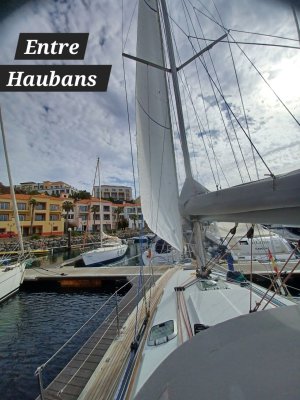You are using an out of date browser. It may not display this or other websites correctly.
You should upgrade or use an alternative browser.
You should upgrade or use an alternative browser.
solent adjustment ?
- Thread starter petibonvm
- Start date
fredrussell
Well-known member
To get the most from a Solent rig, at least upwind, you will benefit greatly from a separate set of ‘inner’ genoa cars/tracks forward on coachroof and sheets from these cars, inside the shrouds back to cockpit. Mine are level with mast, halfway between mast and outer edge of coachroof.
petibonvm
New member
thank you for your reply. I understand, but I only have one rail for the genoa. I'll try between the shrouds, it will already be better than a furled genoa.
neil_s
Well-known member
Between the shrouds on my boat! You could use barber haulers ( as you do on the spinnaker guy ) to improve the sheeting angle of your Solent jib.
onesea
Well-known member
Or sheet outside the shrouds until they just touch yes you might loose afew degrees pointing buy may gain it back in speed with less leeway.
Only way to tell will be sailing winds that you need your Solent and seeing how it sets.
Only way to tell will be sailing winds that you need your Solent and seeing how it sets.
William_H
Well-known member
OP is asking about the sheeting angle for the jib. So while the fore and aft location of the sheeting sheave is important to get the load on the sail correct regarding top versus bottom of the jib, the actual sheeting angle is how close the sheet and clew is to the centre line. This latter on jib is often dictated by sheet track just outside the side of the cabin top however for best performance sheeting angle should be adjustable.
So on the main sail we adjust the sheeting angle equivalent with the main sheet and traveller. ie boom in close for hard on the wind and eased out for reaching or alleviating heel pressure.
Many people will just ease the jib sheet when reaching which then frees off the top of the jib in a very inefficient manner. (top falls away)
Ideally sheeting angle will be adjustable from close to centre line though to well outboard of gunwhale. Though not practical except when we use a whisker pole.
The practical option is to use a barber hauler to haul the clew in board or out board as needed. In board for beating to windward and outboard for reaching or for simply getting more drive in strong winds.
So how far in board can you go in an efficent setting of the jib when hard on the wind? That is difficult to say. The closer you sheet to centre line the closer you are able to sail to the wind while avoiding luffing but the less drive forward you get.
Now one might expect that using a solent is when wind is strong and waves are large and on the nose. You will need powerful drive even when beating in to wind so one might suggest not too close to centre line.
OP could try barber haulers especially hauling outwards but may in fact get better close wind sailing with sheets closer only experiment under typical conditions will give the correct answer. But then of course under these conditions he is probably not in the mood for experimenting. ol'will with no real answer.
PS a barber hauler is a tackle baseed either on cabin top near centre line or on the gunwhale which can haul the sheet out board or in board while the sheet tension is maintained and located fore and aft to give correct pull on foot and leach.
So on the main sail we adjust the sheeting angle equivalent with the main sheet and traveller. ie boom in close for hard on the wind and eased out for reaching or alleviating heel pressure.
Many people will just ease the jib sheet when reaching which then frees off the top of the jib in a very inefficient manner. (top falls away)
Ideally sheeting angle will be adjustable from close to centre line though to well outboard of gunwhale. Though not practical except when we use a whisker pole.
The practical option is to use a barber hauler to haul the clew in board or out board as needed. In board for beating to windward and outboard for reaching or for simply getting more drive in strong winds.
So how far in board can you go in an efficent setting of the jib when hard on the wind? That is difficult to say. The closer you sheet to centre line the closer you are able to sail to the wind while avoiding luffing but the less drive forward you get.
Now one might expect that using a solent is when wind is strong and waves are large and on the nose. You will need powerful drive even when beating in to wind so one might suggest not too close to centre line.
OP could try barber haulers especially hauling outwards but may in fact get better close wind sailing with sheets closer only experiment under typical conditions will give the correct answer. But then of course under these conditions he is probably not in the mood for experimenting. ol'will with no real answer.
PS a barber hauler is a tackle baseed either on cabin top near centre line or on the gunwhale which can haul the sheet out board or in board while the sheet tension is maintained and located fore and aft to give correct pull on foot and leach.
Members online
- noelex
- 3663Ian
- Clash
- MystereMarcus
- st599
- Boathook
- justanothersailboat
- PeterKLimb
- Solwaycruiser
- Hoolie
- E39mad
- KevinV
- sc25 Sweden
- Minerva
- AntarcticPilot
- michael_w
- ridgy
- reallycoliholic
- Aquafan
- GrahamP
- Hot Property
- jwilson
- Stingo
- rculley82
- CrossedThreads
- antony s
- phlip
- franksingleton
- Slipperman
- Puffin10032
- Poecheng
- Agigrower
- usernamesteve
- Baggywrinkle
- Bouba
- DavidJ
- LoneHort
- Nauti Fox
- garymalmgren
- bikedaft
- Wansworth
- andsarkit
- TheoSr
Total: 874 (members: 57, guests: 817)


